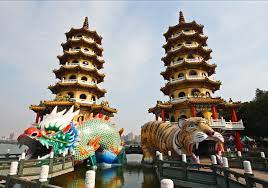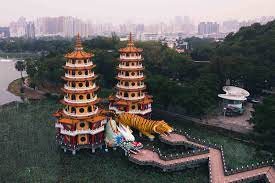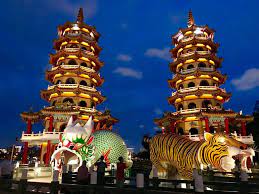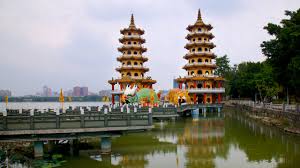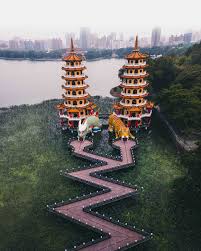The Dragon and Tiger Pagodas, often collectively referred to as the Dragon Tiger Tower, are iconic landmarks located in Kaohsiung, Taiwan. These colorful and ornate pagodas are known for their vibrant architecture, cultural significance, and the unique experience they offer to visitors. Here's more about the Dragon and Tiger Pagodas: Location: The Dragon and Tiger Pagodas are situated in the Lotus Pond area of Kaohsiung, a major city in southern Taiwan. Design and Symbolism: The pagodas are intricately designed and adorned with colorful decorations, intricate carvings, and intricate details. The Dragon Pagoda represents strength and courage, while the Tiger Pagoda symbolizes power and protection. Climbing up through the dragon's mouth and down through the tiger's mouth is believed to bring good luck and ward off bad luck. Key Features: Entrances: Visitors typically enter the pagodas through the open mouth of the dragon and exit through the tiger's mouth. The experience is said to represent entering the dragon's domain and exiting as if reborn through the tiger. Interior and Artworks: Inside the pagodas, you'll find colorful murals, paintings, and sculptures depicting various deities, mythological creatures, and Buddhist teachings. Visitors can climb the spiral staircase to reach the upper levels of the pagodas, where they can enjoy panoramic views of the surrounding area. Cultural Significance: The Dragon and Tiger Pagodas hold spiritual and religious significance for many visitors. People visit to seek blessings, good fortune, and protection. Lotus Pond Area: The pagodas are located in the larger context of Lotus Pond, a scenic area with several other temples, pavilions, and landmarks. The area is known for its tranquil setting and cultural attractions. Local Activities: The vicinity of the Dragon and Tiger Pagodas is often bustling with activity, including local vendors, artisans, and street food stalls. Accessibility: The pagodas are easily accessible by public transportation or taxi from various parts of Kaohsiung. Admission to the pagodas is usually free. Visiting Tips: Remember to remove your shoes before entering the pagodas, as is customary in many Asian temples. Be respectful of the religious and spiritual significance of the site, and avoid touching or damaging any artworks. Enjoy the opportunity to take photographs and capture the colorful beauty of the pagodas and their surroundings.


